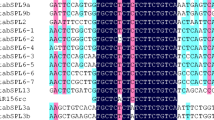Abstract
We have demonstrated recently that the genes encoding the U3 small nuclear RNA (snRNA) in dicot plants are transcribed by RNA polymerase III (pol III), and not RNA polymerase II (pol II) as in all other organisms studied to date. The U3 gene was the first example of a gene transcribed by different polymerases in different organisms. Based on phylogenetic arguments we proposed that a polymerase specificity change of the U3 snRNA gene promoter occurred during plant evolution. To map such an event we are examining the U3 gene polymerase specificity in other plant species. We report here the characterization of a U3 gene from wheat, a monocot plant. This gene contains the conserved promoter elements, USE and TATA, in a pol III-specific spacing seen also in a wheat U6 snRNA gene characterized in this report. Both the U3 and the U6 genes possess typical pol III termination signals but lack the cis element, responsible for 3′-end formation, found in all plant pol II-specific snRNA genes. In addition, expression of the U3 gene in transfected maize protoplasts is less sensitive to α-amanitin than a pol II-transcribed U2 gene. Based on these data we conclude that the wheat U3 gene is transcribed by pol III. This observation suggests that the postulated RNA polymerase specificity switch of the U3 gene took place prior to the divergence of angiosperm plants into monocots and dicots.
Similar content being viewed by others
References
Bogenhagen DF, Brown DD: Nucleotide sequences in Xenopus 5S DNA required for transcription termination. Cell 24: 261–270 (1981).
Brown JWS, Waugh R: Maize U2 snRNAs: gene sequence and expression. Nucl Acids Res 17: 8991–9001 (1989).
Dahlberg JE, Lund E: The genes and transcription of the major small nuclear RNAs. In: Birnstiel ML (ed) Structure and Function of Major and Minor Small Nuclear Ribonucleoprotein Particles, pp. 38–70. Springer-Verlag, Berlin (1988).
Goodall GJ, Kiss T, Filipowicz W: Nuclear RNA splicing and small nuclear RNAs and their genes in higher plants. Oxford Surv Plant Mol Cell Biol (in press).
Goodall GJ, Wiebauer K, Filipowicz W: Analysis of premRNA processing in transfected plant protoplasts. Meth Enzymol 181: 148–161 (1990).
Gouy M, Li W-H: Molecular phylogeny of the kingdoms animalia, plantae, and fungi. Mol Biol Evol 6: 109–122 (1989).
Gupta S, Reddy R: Compilation of small RNA sequences. Nucl Acids Res 19: 2073–2075 (1991).
Hori H, Osawa S: Origin and evolution of organisms as deduced from 5S ribosomal RNA sequences. Mol Biol Evol 4: 445–472 (1987).
Hughes JMX, Konings DAM, Cesareni G: The yeast homologue of U3 snRNA. EMBO J 6: 2145–2155 (1987).
Jeppesen C, Stebbins-Boaz B, Gerbi SA: Nucleotide sequence and secondary structure of the Xenopus U3 snRNA. Nucl Acids Res 16: 2127–2148 (1988).
Kass S, Tye K, Steitz JA, Sollner-Webb B: The U3 small nucleolar ribonucleoprotein functions in the first step of pre-ribosomal RNA processing. Cell 60: 897–908 (1990).
Kiss T, Solymosy F: Molecular analysis of a U3 RNA gene locus in tomato: transcriptional signals, the coding region, expression in transgenic plants and tandemly repeated pseudogenes. Nucl Acids Res 18: 1941–1949 (1990).
Kiss T, Marshallsay C, Filipowicz W: Alteration of the RNA polymerase specificity of U3 snRNA genes during evolution and in vitro. Cell 65: 517–526 (1991).
Lörz H, Baker B, Schell J: Gene transfer to cereal cells mediated by protoplast transformation. Mol Gen Genet 199: 178–182 (1985).
Marshallsay C, Kiss T, Filipowicz W: Amplification of plant U3 and U6 snRNA gene sequences using primers specific for an upstream promoter element and conserved intragenic regions. Nucl Acids Res 18: 3459–3466 (1990).
Mèmet S, Saurin W, Sentenac A: RNA polymerases B and C are more closely related to each other than to RNA polymerase A. J Biol Chem 263: 10048–10051 (1988).
Mühlbach H-P, Sänger HL: Viroid replication is inhibited by α-aminitin. Nature 278: 185–188 (1979).
Murphy S, Moorefield B, Pieler T: Common mechanisms of promoter recognition by RNA polymerases II and III. Trends Genet 5: 122–126 (1989).
Parker KA, Steitz JA: Structural analyses of the human U3 small ribonucleoprotein particle reveal a conserved sequence available for base pairing with pre-rRNA. Mol Cell Biol 7: 2899–2913 (1987).
Parry HD, Mattaj IW: Snurpogenesis: the transcription and assembly of U-snRNP components. Trends Biochem Sci 14: 15–19 (1989).
Porter GL, Brennwald PJ, Holm KA, Wise JA: The sequence of U3 RNA from Schizosaccharomyces pombe suggests structural divergence of this snRNA between metazoans and unicellular eukaryotes. Nucl Acids Res 16: 10131–10151 (1988).
Reznikov WS, Siegle DA, Cowing DW, Gross CA: The regulation of transcription initiation in bacteria. Annu Rev Biochem 19: 355–387 (1985).
Sambrook J, Fritsch EF, Maniatis T: Molecular Cloning: A Laboratory Manual, 2nd ed. Cold Spring Harbor Laboratory Press, Cold Spring Harbor, NY (1989).
Singh R, Gupta S, Reddy R: Capping of mammalian U6 small nuclear RNA is directed by a conserved stemloop and a AUAUAC sequence: conversion of a non capped RNA into a capped RNA. Mol Biol Cell 10: 939–946 (1990).
Vankan P, Filipowicz W: A U-snRNA gene-specific upstream element and a-30 ‘TATA’ box are required for transcription of the U2 snRNA gene of Arabidopsis thaliana. EMBO J 8: 3875–3882 (1989).
Waibel F, Filipowicz W: U6 snRNA genes of Arabidopsis are transcribed by RNA polymerase III but contain the same two promoter elements as pol II-transcribed U-snRNA genes. Nucl Acids Res 18: 3451–3458 (1990).
Waibel F, Filipowicz W: RNA-polymerase specificity of transcription of Arabidopsis U-snRNA genes determined by promoter element spacing. Nature 346: 199–202 (1990).
Wolfe KH, Nanolo G, Yang Y-W, Sharp PM, Li W-H: Date of the monocot-dicot divergence estimated from chloroplast DNA sequence data. Proc Natl Acad Sci USA 86: 6201–6205 (1989).
Author information
Authors and Affiliations
Rights and permissions
About this article
Cite this article
Marshallsay, C., Connelly, S. & Filipowicz, W. Characterization of the U3 and U6 snRNA genes from wheat: U3 snRNA genes in monocot plants are transcribed by RNa polymerase III. Plant Mol Biol 19, 973–983 (1992). https://doi.org/10.1007/BF00040529
Received:
Accepted:
Issue Date:
DOI: https://doi.org/10.1007/BF00040529




